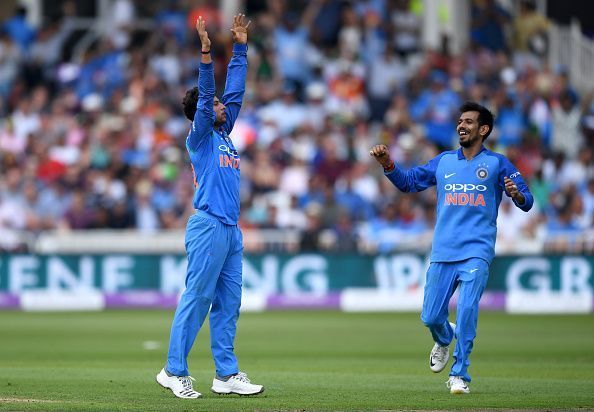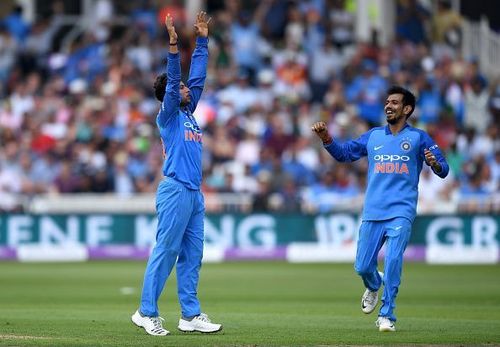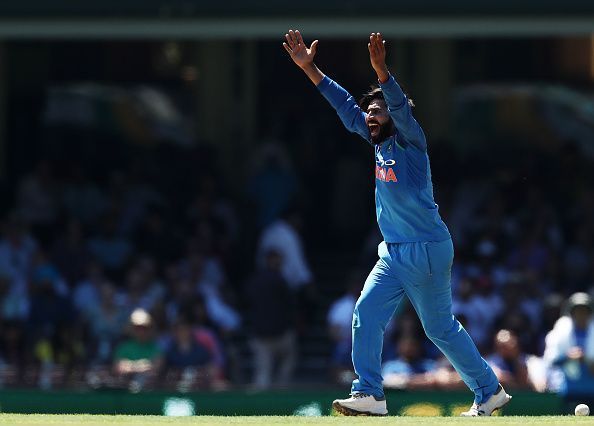
Yuzvendra Chahal reasserts why we need wicket taking bowlers in ODIs

After a sensational tour of South Africa and the Nidahas Trophy, Yuzvendra Chahal's career took a bit of a backseat. His spin twin Kuldeep Yadav took center stage in the limited overs format, finishing as the leading wicket-taker on the tours of Ireland, England, Asia Cup as well as in the home series against West Indies.
Even in this period, Chahal was better many frontline spinners from many countries. The only thing is that he was not being able to penetrate as effectively as Kuldeep Yadav during this period. But the fact of the matter is that India was at their best at taking wickets in the middle overs whenever "Kul-Cha" hunted as a pair.
Post the ICC Champions Trophy played in England in 2017, the two have picked up 119 wickets for India in less than 40 matches together. Their combined economy rate is less than 5 and their combined strike rate is less than 30. That means that if they bowl together, even on an average day they will concede around 100 runs and pick 4 wickets in the middle overs. So if India bowls decently with the new ball and during the death, they should win on more days than not with the two wrist-spinners in the side.
Having played no international cricket for over two months despite being in the limited overs squads, Chahal finally got a look in today. Chahal was surprisingly brought in for Kuldeep Yadav - the highest wicket-taker in all international cricket last year. The move might have been yet another one of Virat Kohli's many experiments to prepare for the World Cup. But the main reason the two are not playing together more often is the recent resurgence of the role of the spinning all-rounder.
Hardik Pandya, who was and is still being seen as the first choice all-rounder for India's World Cup campaign, injured himself during the Asia Cup. That coincided with the injury of India's third spinner for that tournament Axar Patel. Kuldeep and Chahal's pair was going great guns till that point, and it seemed difficult for any other spinner to break in.
Ravindra Jadeja was flown in as the replacement to Axar Patel while Deepak Chahar came in for Pandya. Jadeja, who was in good all-round form during the England tour was out of limited overs reckoning for over a year till that point. Hence, Jadeja became the first choice for India's all-rounder position held by Pandya at that time - a position Jadeja held for four years previously.

Jadeja kept doing well on helpful wickets, and is always neat with his line and length otherwise. But Pandya's extended absence which came as a result of his suspension has helped Jadeja get an extended run. Jadeja might not be directly occupying Kuldeep or Chahal's place in the side, but it certainly forces the captain to go in for an extra seamer while having to miss out on one of his specialist spinners.
However, for an argument that has been going on for quite a while now - India rather play two specialist spinners who can pick wickets even if they get hit, rather than attacking from one end and holding up the other. Hence, India rather plays Kuldeep and Chahal first and then think about the all-rounder. Here is why.
You might argue that India's tail gets longer if you replace Kuldeep or Chahal with Jadeja. But the point is that Kuldeep and Chahal playing together can result in 5-6 wickets or more on most days. Their combined 33 wickets from 6 matches in South Africa was a fine example. If the second spinner in the team can take two to three wickets at anything less than 49 for 1 (Jadeja's average figures during the ongoing ODI series against Australia), that certainly helps the team.
If the opposition team is 200 odd runs for 6 odd wickets after the 40 over mark, the team is most likely to concede a maximum of 250 runs compared to 300 runs in every second match. Those 50 runs saved are 20 runs more than Ravindra Jadeja's batting average of 30. The only reason India could restrict Australia well under 250 today was because of Chahal's brilliant spell of six wickets.
Ravindra Jadeja should certainly be a part of India's World Cup spells. His presence in the dressing room and in the field would certainly be invaluable. And he would come in at some point with his all-around skills. But he is not one of the country's top four white-ball bowlers. He should certainly be playing as the third spinner, and the wrist-spin duo has time and again proved that regardless of the surface, they will pick wickets.